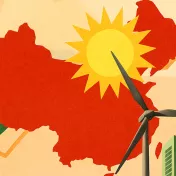The year 2019 will be key for future climate policy in Germany and Europe. Finance plays a key role in improving climate protection and sustainable growth.
To this end, Germany should learn from pioneering countries for "Green Finance". In the seven articles in our series, international authors will therefore explain their country's approach towards a green financial system, addressing opportunities, hurdles and unanswered questions.
Green growth with open questions
The global commitment to the Sustainable Development Goals and the Paris Agreement reflect that the "elephant in the room" has received wide attention. Severe problems such as environmental pollution, natural resource depletion and climate change arising from development-oriented economic activities are nowadays internationally recognized.
According to an analysis of the Organization for Economic Co-operation and Development (OECD ), capital of US$6.9 trillion needs to be allocated annually to finance the global transition towards a sustainable economy until 2030.
Responding to this unprecedented funding demand, green finance has developed as an innovative approach to accelerate and support sustainable development through market mechanisms and financial instruments such as green credits, green bonds, and green insurance.
"Green Credit Guidelines" since 2012
China has been at the forefront of the international discourse on green finance as evidenced by a series of policy commitments and actions taken. In 2012, the China Banking Regulatory Commission issued the Green Credit Guidelines to encourage banking institutions to develop green credits.
In 2016, Guidelines for Establishing the Green Financial System were released by seven government ministries led by The People’s Bank of China. With the release of these guidelines, China became the first government to promote the establishment of a green finance system based on a top-down approach.
Based on these guidelines the balance of green loans by 21 major banks in China had reached more than 8 trillion RMB (approximately US$1.2 trillion) by the end of 2018 – an increase of 16% per cent from 2017 .
Considering the massive scale and rapid growth of funding flowing into infrastructure investment on a green basis, concerns and questions arise, e.g.:
- Which investments can be considered as green and compatible with the Paris climate targets?
- Has the capital invested domestically and overseas been appropriately scrutinized such that it is in line with the current mechanism and guidelines?
Implementations of green projects within China are under rather strict national legislate emission and pollution control standards.
However, when issuing green funds internationally – especially towards countries that are yet to develop, have less ambitious climate action targets and a lack of legislation on environmental and social responsibility – the question arises whether these guidelines will help investors effectively identifying and manageing their clients in order to prevent potential environmental and social risks also overseas.
Guidelines also apply for China’s investments overseas
China's definition of "green" within its Green Credit Guidelines emphasizes tackling environmental protection, pollution and emission control, as well as reaching a more efficient resource utilization.
Regarding China’s investments overseas, social impacts and risks for indigenous people as well as for employees and gender issues are not addressed. They should be added to the current environment-based scheme.
Furthermore, compared to international standards, the threshold of green finance projects in China tends to be more lenient. This is especially reflected in identifying clean coal investments as one of the green industries within the Green Credit Guidelines.
However, the Green Credit Guidelines require Chinese financial institutions to enhance environmental and social risk management of overseas projects – before issuing credit. This should ensure that the implementers of those projects abide by national or regional laws and regulations in environmental protection, land, healthcare, and security.
The Guidelines for Establishing the Green Financial System intend to strengthen environmental and social risk management as well as improve information disclosure in implementing China’s green financing and investment activities domestically and overseas.
Questions remain open
However, issues remain on the enforcement and implementation level since the guidelines are voluntary and lack operational instructions, especially when banks and investors are not yet equipped with related knowledge and capacity, which is the current reality in China.
To conclude, the incorporation of Green Finance into national political strategies and policies is of great importance for a fast and stable transformation as it informs financial actors and companies on what they need to prepare for.
However, to even improve its current legislation, China should further align its current standards with internationally well-recognized norms and best practices and establish a more effective and accountable implementing mechanism.

Foto: Greenovation Hub | YAO Anqi, Program Officer, Greenovation Hub Anqi works on policy research regarding green finance, overseas investment, development finance and environmental policies. She has adequate project-related/research experiences regarding environmental sustainability, meeting the challenge of climate change, and Eco-City. Greenovation Hub is an environmental NGO with a global outlook. Greenovation Hub promotes the development and implementation of sound climate and environmental friendly policies through conducting in-depth analysis and research, and fostering dialogues among stakeholders, in order to drive China's green transition towards a sustainable, equitable and climate resilient future, contributing to the reduction of global ecological footprint. |

With the financial support of Stiftung Mercator. The author and Germanwatch are responsible for the content.
The blog post was first published at www.klimareporter.de and is available in German.




